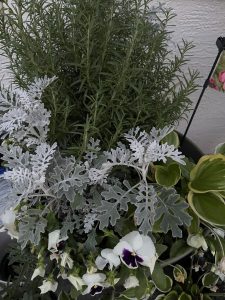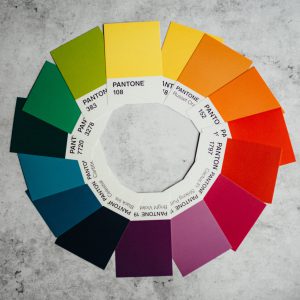Many of us love to garden or have had gardens we have loved over the years. Entire gardens can be a lot of work and can be expensive especially if you are paying someone else to do it! While I work on a thoughtful design for layout and plantings for my back yard, my energy has been focused on container gardens. I enjoy plantings in several containers that are in my front patio. Containers create wonderful opportunities and elevate plants closer to us!
A holiday tree-sheared rosemary which smells marvelous can be the beginning to revamping a larger container. What may have been cannas, dusty

miller, blue daze, and coleus, became that rosemary, bright white pansies, the same dusty miller and lovely Florida hostas. While this container was a more significant revamp, planning to keep one larger plant (an anchor) and only trading out small plants to reflect the season can refresh the container without significant expense. You may need to add more potting media if removing and adding smaller plants into the design based on season.
As we are approaching some warmer temperatures, you may consider trying a few planters. One approach is to use a mixture of types of plants such as perennials which return three years or more, annuals which last only one year from seed, and perhaps even woody plants. You could also use just one exceptional single plant.
If creating a mixed container, think about the layout of your container. Is it going to face one direction or be viewed from all sides? The view can change the layout of plants within your container.

As you select your plants you may incorporate principles and elements of design which you may have used when thinking about your landscape. Color, texture, unity, can create an interesting visual planting. A container planting would be dull if all plants had the same color or the same texture. Add a plant with a course texture to break up the monotony of a planting. Use a range of hues of one color, or analogous (three colors close to each other on the color wheel) or my favorite – complementary colors which are across the color wheel from each other often giving a good color pop. If you are using only one plant in a container, think carefully about the container color. You don’t want the selected plant and the container color to clash.
One important aspect of container gardens is water, media and sun needs. If you have reclaimed water, you will need to use a garden hose (based on potable water from your home) rather than your irrigation if you plant to harvest and eat the edible parts of your container’s plants. Reclaimed water is not good to ingest on raw vegetables. If you’re growing broccoli, for example, and you plan to cook it, fantastic, but if you wanted to make a broccoli salad without cooking, that should not be done with reclaimed water. There are many types of media to use in containers. Do not use “garden soil” which is not intended for containers. If you have gardened for a while and wanted to get your media tested, UF/IFAS does have a media test form. Read labels of your plants for their sun requirements – sun, part sun, or shade. Plants do best when grown in their preferred sun aspect. In selecting pots, terracotta pots dry faster while glazed pots tend to hold moisture.
To read more on container gardens for outdoor spaces, visit https://edis.ifas.ufl.edu/publication/EP326.
 0
0
